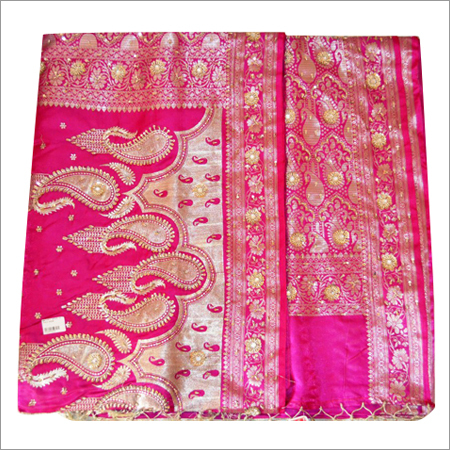The traditional but elegant Banarasi Shari have long been a proud possession of almost any woman’s wardrobe. Marriages in Bangladesh are unthinkable without Benarasi sarees. This wedding attire brings to mind gorgeous sarees studded with motifs of gold adding grace to the radiant bride.
The Benarasi sarees have been immensely popular among women since the Mughal era when all art was amalgamated to create a fusion of aesthetics.
The textiles of Bangladesh are made by simple handlooms, can be traced to the same roots and intricately linked with our history. Fine ‘Muslin’ fabrics of what is now Bangladesh created a stir in those days.
Though the English colonialists tried to uproot the makers of ‘Muslin,’ going to the extent of cutting the index fingers of the artisans, the ancient craft of weaving has been passed down from one generation to the next has become the livelihood of thousands of weavers in Bangladesh.
The end products, the textiles including the Benarasi sarees, have reached the most sophisticated niches of the market, both home and abroad. Thus, this age-old traditional attire has carved out its own place in contemporary lifestyles. They bring into the present, the treasures of the past, and the Benarasi sarees, also a formal wear, as popular as ever.
This art revived soon after partition of India and Pakistan in 1947 when few non-Bengali people of Benaras, presently Varanasi, a well-known city of India, came to Mirpur area of Dhaka and began again to make Benarasi sarees. Later more people became involved with this handloom industry and it spread, and the whole area came to be known as Mirpur Benarasi Palli, located at the north-western edge of the capital.
During Mughal era the raw material, i.e., silk yarn used to come from China and today those are replaced with Rajshahi silks, where sericulture is a unique industry. As before, the weavers weave the basic texture of the saree on the loom. In weaving the warp, they create the base, which runs into 24 to 26 meters.
There are around 5,600 thread wires with 45-inch width. At the weaving loom, three people work. One weaves, the other works at the revolving ring to create lacchis (rolled bundles). At this juncture, another important process is initiated – designing the motifs. There are several traditional artists in Mirpur who, though not formally trained in designing, create wonderful designs for all to behold.
A normal saree takes around 15 days to one month and sometimes six months to complete – it all depends on the intricacy of designs and patterns to be created on the saree. It is said, in yesteryears Benarasi Sarees used to have designs with original gold and silver thread.
Prices of Benarasi saree starts from Tk. 1300 and goes up to Tk. 30,000 depending on the embellishment. Benarasis and Mirpur Katans are holding their own competing with foreign goods. Their prices range from Tk 1,200 onwards depending on how intricate and exclusive the artwork is.
These saris always have flashy names. Whatever Bollywood movie is in the charts, it leaves its name in the Benaroshi Palli. Sari designs are often taken from these movies.
So take some time off your busy schedule to visit the Mirpur Benarasi Palli. It will be worth the visit seeing the weavers and their apprentices at work. You may also purchase sarees from them to take those back home for your dear ones.





